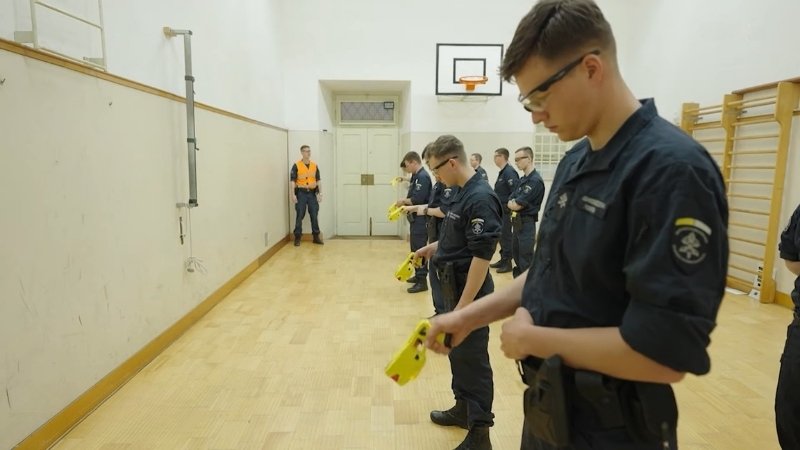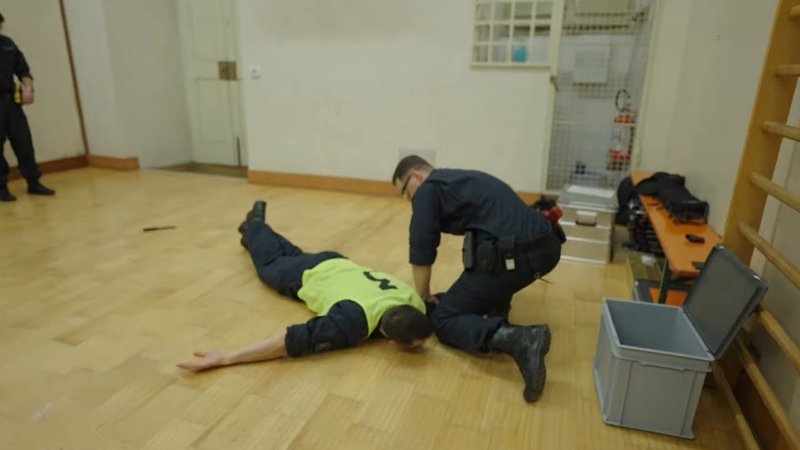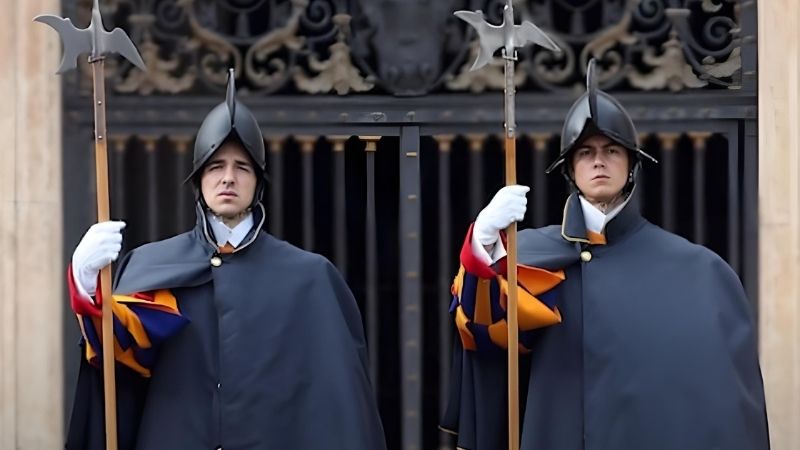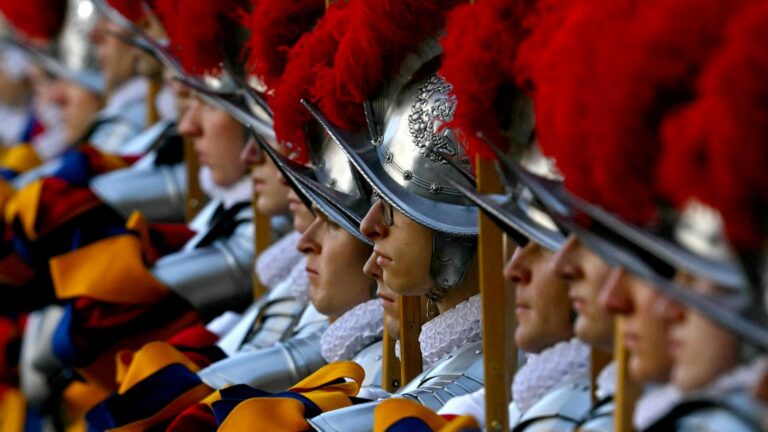To be a Swiss Guard, you must be physically prepared for long hours of standing, sudden bursts of action, and close combat scenarios.
Unlike a standard police officer or soldier, Swiss Guards have unique challenges—they are not just guarding a state but also a religious leader with a constant public presence.
This requires them to be in peak condition at all times. Let’s see how Swiss Guards train.
Swiss Guard Training Highlights
| Physical Fitness | Endurance, strength, agility, daily workouts |
| Combat Training | Hand-to-hand combat, Krav Maga, judo, jiu-jitsu |
| Weapons Proficiency | Glock 19, MP5 submachine gun, precision shooting |
| Crowd Control | Managing large gatherings, de-escalation tactics |
| Crisis Management | Emergency response, VIP protection drills |
| Psychological Resilience | Stress management, situational awareness, negotiation skills |
| Counterterrorism | Active shooter response, security intelligence |
| Ongoing Training | Regular assessments, advanced tactical exercises |
The Daily Fitness Regimen
Each day begins with a structured physical training session designed to improve cardiovascular endurance, strength, and agility. Guards follow a rigorous schedule that includes running, weightlifting, and high-intensity workouts.
A typical morning might start with a three-to-five-kilometer run, improving stamina and lung capacity. This is followed by weight training, where they focus on building upper-body and core strength. Exercises like bench presses, squats, and deadlifts ensure that guards are strong enough to handle emergency situations, including lifting or carrying individuals to safety.
Flexibility and injury prevention are also a priority, so guards incorporate stretching, yoga, and mobility exercises into their routine. This helps them avoid muscle strains, especially considering the long hours they spend standing guard.
Strength and Combat Conditioning

A Swiss Guard is more than just a sentry; he must be ready for hand-to-hand combat at any moment. This is why they undergo specific combat conditioning exercises that simulate real-life confrontations.
To prepare for potential altercations, guards practice bodyweight exercises such as push-ups, pull-ups, and lunges, all of which enhance functional strength. In addition to standard gym workouts, they perform drills that mimic security situations, including carrying weighted gear, sprinting with resistance, and obstacle course training.
Hand-to-hand combat is another critical component. Swiss Guards train in martial arts like Krav Maga, a self-defense system used by military personnel worldwide, along with judo and jiu-jitsu, which allow them to neutralize an attacker without resorting to lethal force. Their training ensures that they can subdue a threat effectively, even if they are unarmed.
Tactical Training
The Vatican may be small, but it remains a high-profile target. This means that Swiss Guards must be experts in security tactics, firearms training, and threat assessment. Their preparation goes beyond traditional security work, focusing on rapid decision-making and elite defensive techniques.
Weapons Training and Firearm Proficiency

While the Swiss Guard is best known for carrying halberds—long ceremonial weapons dating back to the 16th century—their real training is focused on modern weaponry. Each recruit undergoes extensive firearms training with handguns, submachine guns, and rifles.
They become proficient with weapons like the Glock 19, a widely used semi-automatic pistol, and the Heckler & Koch MP5, a submachine gun favored by elite security forces. Firearms training includes target shooting, rapid reload drills, and high-pressure shooting scenarios designed to simulate real-world threats.
Precision is key. Swiss Guards must be able to hit a target accurately under stress, which is why they practice regularly in controlled shooting environments. Their training includes shooting in low-light conditions, engaging moving targets, and reacting to surprise threats.
Crowd Control and Crisis Management

One of the most challenging aspects of Swiss Guard duty is managing large crowds. Every day, thousands of visitors pour into the Vatican, and during major events, the number can swell into the tens of thousands. Maintaining order and preventing security breaches is a constant challenge.
Guards receive specialized training in crowd control, learning how to identify potential threats in a dense public setting. They study patterns of suspicious behavior and practice de-escalation techniques to handle aggressive individuals.
In addition to crowd management, they participate in simulated crisis drills. These include scenarios like an attempted attack on the Pope, a sudden outbreak of violence in St. Peter’s Square, or a security breach within Vatican walls. Guards must react swiftly, using their training to contain the situation while protecting bystanders.
Psychological Training
A Swiss Guard’s duty is not just physical—it’s mental. Protecting the Pope is a unique role that comes with immense pressure. A single mistake could have devastating consequences. That’s why psychological resilience is a key component of their training.
Building Mental Toughness

From day one, recruits are trained to remain calm under pressure. They undergo exercises designed to enhance focus, quick decision-making, and emotional control. This includes:
- Stress management techniques that help them stay composed during high-stakes situations.
- Situational awareness training that teaches them how to assess threats before they escalate.
- Verbal de-escalation tactics that allow them to defuse confrontations without using force.
Swiss Guards are taught that avoiding conflict is often more effective than engaging in it. A well-placed command, a firm posture, or even a calm voice can prevent a situation from spiraling out of control.
Crisis Negotiation and Communication Skills
In some cases, the ability to talk someone down is more important than physical force. Guards receive crisis negotiation training, learning how to communicate with potential aggressors and defuse situations before they become violent.
This is especially critical during papal events when the risk of mentally unstable individuals attempting to breach security is higher.
Ongoing Training
Becoming a Swiss Guard is one thing, but maintaining their level of expertise is another. Their training is never truly over.
Regular Fitness and Tactical Assessments
Every guard is required to pass periodic fitness tests, ensuring they maintain their strength and endurance. In addition to physical evaluations, they undergo routine firearms and tactical re-certifications. These assessments ensure that they remain highly skilled and ready for any potential crisis.
Counterterrorism and Special Training
In recent years, Swiss Guards have expanded their training to include counterterrorism tactics. This involves learning how to respond to active shooter scenarios, bomb threats, and cyber threats. They also collaborate with other elite security forces, including Swiss military units and Italian law enforcement, to stay up-to-date on the latest security protocols.
Final Thoughts
The Swiss Guard may be steeped in tradition, but their training is anything but outdated. They are one of the most highly trained security forces in the world, balancing history with modern expertise. Their preparation involves intense physical conditioning, advanced tactical instruction, psychological resilience, and continuous skill development.
While they may look like medieval warriors, their capabilities are entirely modern. From firearms training to hand-to-hand combat, crisis management to counterterrorism drills, Swiss Guards are far more than just ceremonial figures—they are elite protectors dedicated to defending one of the most important leaders in the world.

